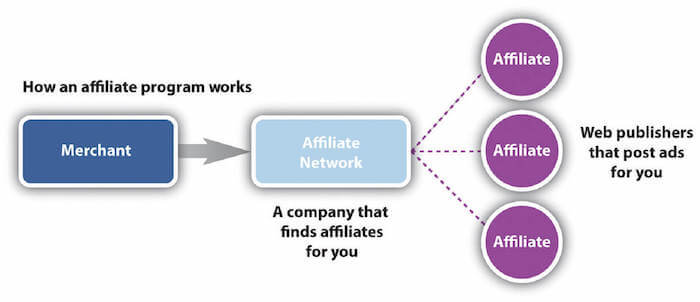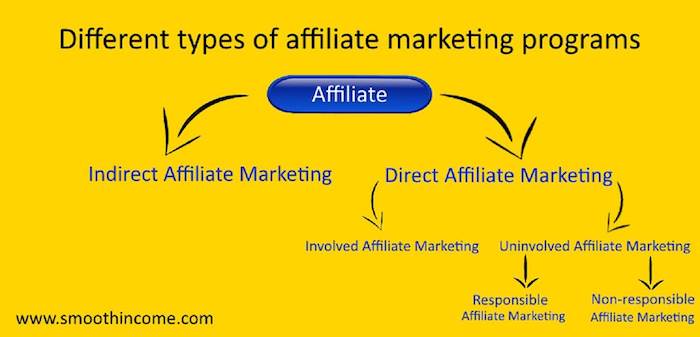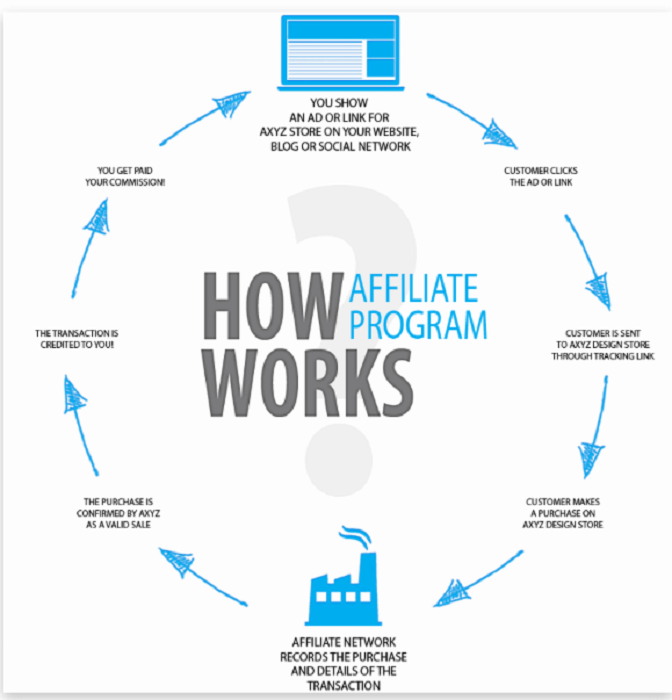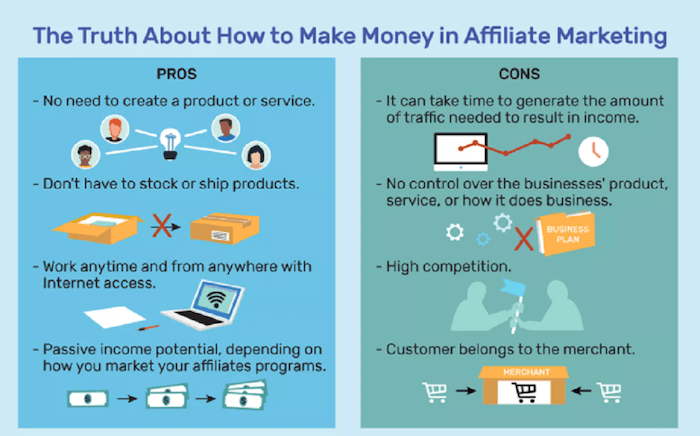Are you an avid blogger? A content creator? Or perhaps an influencer with a huge social following? If you have traffic, it can bring you hundreds of thousands of dollars!
Yes; monetizing your blog or social media following is absolutely doable, provided you know- “how.”
Thanks to fast-paced technological advancements, there are numerous ways to earn passive income. Affiliate marketing is one of the foremost leading ways to do it. Through Affiliate Marketing you can bank upon numerous money making opportunities. If you run a successful website or a blog with steady traffic flow, then affiliate marketing is a perfect way to make passive income.
After all, who doesn’t want to make some extra income!
Want to leverage the potential of affiliate marketing to boost your earnings? This article will take you through an in-depth picture of affiliate marketing and guide you on how to get started in affiliate marketing as a complete beginner.
Affiliate Marketing – An Overview
Affiliate marketing is a performance-based marketing channel, wherein an affiliate (publisher) gets paid (commissions) every time they promote a brand, product or service, and drive a sale. Companies (merchants/advertisers) typically pay commissions per sale and rarely by clicks, impressions, or referrals.
Rapid influx of the internet in everyday lives has increased the prominence of affiliate marketing today. Digital marketing, cookies, and powerful analytics have further made affiliate marketing a billion-dollar industry. Significantly beneficial to both affiliate marketers and brands, the new drive towards this less traditional marketing approach is the latest trend. Here are some stats on Affiliate marketing:
- 84% of publishers and 81% of brands use the power of affiliate marketing, and this number is expected to grow every year in the United States
- Worth $12 billion, the affiliate marketing industry is growing at a rapid pace
- 40% of U.S. merchants consider affiliate marketing as a top customer acquisition strategy
- On average, 65% of affiliate marketers drive traffic by blogging
Numbers don’t lie! The above statistics clearly indicate how big the affiliate marketing industry is today- and poised to grow in the coming years too.
However, it is easy said than done. Affiliate marketing isn’t for everyone. It demands performance, not potential. Therefore, an affiliate marketer needs to have a strong audience base that can be converted into referral or sales.
Merchants or advertisers are also pretty choosy about their publisher partners because they want results. Only affiliates with a good traffic flow to your website, blog, or social profile gets approved.
Additionally, it is also about engaging website visitors in a way that inspires them to click the affiliate link, visit the merchant’s website, and make a purchase.
If you are a beginner (which you probably are), you should have knowledge of special terms widely used in affiliate marketing. This will help you understand the business model better. Here are some of them:
- Affiliate Program: Affiliate programs are hosted by merchants or brands, wherein an affiliate can refer their website traffic to various products and services, and get paid in return for each sale generated in this process.
- Affiliate Link: It is a link the merchant provides and is unique to each affiliate. It helps to track the traffic and sales using a tracking code.
- Conversion: When a referred website visitor takes a desired action on the merchant’s website.
- Commission: It is a pre-determined amount of money an affiliate gets for each qualified referral or sales coming via his unique affiliate link.
- Cookies: Cookies are used to assign a referral to the affiliate’s ID in order to track their conversion.
- Cookie Duration: Cookies come with expiration, say for instance 30 days or even for life. If a referred customer converts within this period, the sale is attributed to the affiliate and he gets a commission.
- First Click: Some affiliate programs use the first click method. Here, if a user clicks on two different affiliate links to the same product, the conversion will be attributed to the affiliate who brought him with the first click.
- Last Click: It is just the opposite of First Click, i.e., the conversion will be attributed to the affiliate who brought the referral on the second click.
What is an Affiliate Network?
If you are looking to earn a passive income by monetizing your traffic, you’d need to search for affiliate programs in your niche and sign up individually with each merchant. This can be quite cumbersome, especially for beginners.
That’s where affiliate networks come into the picture.

In addition to the affiliate and the merchant, most often there is a vital third party in today’s affiliate marketing mix – the affiliate network.
While some merchants (like Amazon or eBay) prefer to run affiliate programs on their own, most of them partner with an affiliate network to provide the technical solutions that an affiliate program needs.
As such, affiliate networks have numerous merchants signed up to them. This is an advantage for an affiliate. You do not need to scour the internet to find a suitable affiliate programs. All can be found on a single platform- the affiliate network. They provide the option to search merchants in your niche, compare, read affiliate terms & conditions, and sign up directly.
Affiliate networks also provide tracking solutions and reporting, which are powerful tools for affiliates to monitor and optimize your campaign performance. Most merchants (including the big ones) require affiliate networks to perform various functions like hosting creative banners, making commission payouts, and extending support to the affiliates.
In fact, an affiliate network serves as a bridge between publishers and merchants that want to promote their products and services. These networks offer training, valuable resources, and actionable insights to help you become a successful affiliate marketer.
There are several good affiliate networks, with thousands of merchants and products on board. Some popular affiliate networks are:
- ShareASale
- AWIN
- ClickBank
- CJ Affiliate
- Rakuten
- FlexOffers
Here are some quick reasons why you should join an affiliate network:
- Connect to hundreds – even thousands – of products and brands. This offers a more straightforward and hassle-free way to monetize your traffic and earn extra income
- Only choose products and services that are most relevant to your audience
- You do not require to chase affiliate payouts with each merchant you sign up; the platform will handle it for you
- Get access to analytics and reporting tools, which enables you to track your progress
However, there are some cons to affiliate networks that you should be aware of. Some (in fact most) require websites or blogs to have a particular amount of traffic before they can join. Several others also have low average commission rates. However, overall, they are an effective way to monetize your blog and make passive income.
Different Types of Affiliate Marketing
Affiliate marketing programs can be differentiated based on how they work. Let’s go through them.

Involved Affiliate Marketing:
In this type of affiliate marketing, there is a deep connection between the affiliates and the products/services they are promoting. They have personally used the product and have positive experiences, which they can share with others. Their experiences work per the merchant’s advertisement and they are considered a reliable source of information.
However, in this form of affiliate marketing, the product promotion does not come in the form of a banner ad or “recommended resources.” The affiliate’s personal experience with the product or service is presented as a part of the content.
It’s the affiliate’s direct experience or involvement that makes the affiliate offer more attractive. However, there should also be a sense of responsibility when you make recommendations, particularly when you have a lot of followers.
This is completely opposite of PPC affiliate marketing, where there is no association between the affiliate and the consumers. Rather, here you are directly talking to them and recommending a product. It isn’t just about making money; it is using your authority and trust to provide valuable recommendations that will inspire people to buy.
Uninvolved Affiliate Marketing:
This is a basic PPC marketing campaign where the affiliate does not have authority in the niche or claim to use the products/services they are promoting. This is an uninvolved affiliate marketing strategy where the affiliates do not have related skills or expertise in the product or service. There is also a lack of attachment with the potential customers.
All that an affiliate does is place an affiliate link via Facebook Ads, Google AdWords, etc., hoping that someone will click on the link and purchase the product. In return, the affiliate will get a commission.
This is a popular type of affiliate marketing because you do not require any authority or presence. It takes time building a fan following and many people do not have the time to commit working on a website or blog. Through this type of affiliate marketing, they can get started to promoting products and services right away.
Uninvolved affiliate marketing can be differentiated into two types:
- Responsible affiliate marketing
- Non-responsible affiliate marketing
Responsible Affiliate Marketing:
In this form of uninvolved affiliate marketing, there is a certain level of responsibility that affiliates need to maintain when they make some recommendations. This matters especially when the affiliate has a lot of influence and authority over the followers. YouTube channels, review sites, blogs, etc. follow this form of affiliate marketing.
Non-Responsible Affiliate Marketing:
In uninvolved affiliate marketing strategy there exists no association between the affiliate and the end consumers. The affiliate promote products and services in the form of price comparison, reviews, discount coupons, etc. A consumer reads this, understands the offer, and makes a purchase decision – they do not necessarily know the affiliate who is promoting the same.
Sweepstakes and contest sites, coupon sites, product and price comparison sites, reward and cash-back sites, etc. follow this form of affiliate marketing.
How Can You Make Money Through Affiliate Marketing?

This is how affiliates make money through this program:
- The affiliate or publisher signs up with an affiliate network or a particular merchant in their niche
- Upon getting approved as an affiliate, they get access to banner ads, text links, and other creatives. These can be placed on the affiliate’s website, blog, or social profile to promote the merchant’s products or services
- Interested visitors click the link on the affiliate’s website and get directed to the product or brand page. A cookie is stored on the visitor’s web browser. The cookie enables the affiliate network or the merchant to track the visitor’s progress right from the affiliate’s website or blog and through to the shopping cart
- The visitor takes an action on the merchant’s website or makes a purchase. The affiliate network or the merchant will then verify whether it is a qualified sale as per affiliate terms & conditions
- For each qualified referral or sale, the network or the merchant pays out a commission as per the pre-determined amount/percentage. However, you can withdraw the commission only when your account accrues the minimum payout limit.
How do you get paid in Affiliate Marketing?
There are several ways affiliates get paid in an affiliate marketing program. It varies depending on the commissioning system the merchant uses.
Some of the most common ways you can earn money in affiliate marketing are:
Pay-Per-Click (PPC)
This is the simplest form of affiliate marketing, wherein the affiliate gets paid every time they refer a qualified visitor to the website. That means whenever a website visitor clicks on your affiliate link or banner and gets directed to the merchant’s website, you will get paid.
You get the commission irrespective of whether the referrals take any specific action on the website. However, the commissions of PPC are pretty low and not many merchants offer this type of affiliate program.
Pay-Per-Lead (PPL)
In this type of affiliate marketing program, you will get paid for each converted lead. This means whenever your referred visitor signs up or fills in a form on the merchant’s website that includes details such as their email phone number and address, he or she becomes a lead and you will receive a commission for the same.
Pay-Per-Sale (PPS)
This is the most common type of affiliate marketing. Here, you will get paid a specific commission amount when your referrals make a purchase on the merchant’s website. The commission is determined as a certain percentage of the product value.
One-time Commissions
In this type of affiliate marketing, the commission is paid to the affiliate only once when a referred customer completes a qualified action on the merchant’s website.
Recurring Commissions
These are subscription-based programs, wherein affiliates will receive commissions as long as their referred customers remain signed up and make a purchase.
Sitewide Commissions
There are some affiliate programs that pay the affiliates sitewide commissions. This means the affiliate will get paid for all purchases their referred customers make throughout the site.

How Can You Promote Affiliate Marketing Links
According to a report, publishers consider affiliate links to be one of the top revenue-earners for their website than any other form of marketing. This is because there are numerous tactics, campaigns, forms of content, and platforms through which you can promote affiliate links.
Discussed here are top channels through which you can promote affiliate marketing links and earn passive income.
#1 - Product Reviews
When you join as an affiliate, it is important to thoroughly understand the products or brands you choose to promote. Use this knowledge to write honest product/service reviews that will engage your audience. The review should cover in-depth information about the product and highlight points that will inspire your visitors to click.
Insert the affiliate link anywhere in the review to generate clicks in a fair, objective, and transparent manner.
#2 - Automated Welcome Emails
If you want to make the most of an affiliate program and earn a steady income, it is crucial to building a loyal following of audiences who can convert into potential sales. Email marketing is a powerful tool in this process- driving more visitors to your website, distributing affiliate content, and managing relationships.
When visitors subscribe to your blog or email newsletters, you can send them automated emails, including affiliate links with relevant articles about the product or service you are promoting. But make sure not to be spammy with your links.
#3 - Affiliate Banners
Apart from including text links in your blog post or website, you can also provide links in the form of affiliate banners. These clickable banners can be placed on your website, including the sidebar, header & footer, email marketing messages, or embedded in the content.
However, check whether your affiliate program provides you access to clickable banner ads. If yes, copy and paste the HTML anywhere on your website that would instantly catch the attention of your visitors.
#4 - YouTube Affiliate Links
Videos are effective marketing tools, particularly for affiliates. You can create engaging video content around the product or service you promote and include the affiliate link in it. You can do this in two ways – (i) include the affiliate link in the video description and (ii) Use YouTube annotations and hyperlink each box with your affiliate link. You can use both these methods to make the most of the affiliate program.
#5 - Tools or Resources Pages
To generate steady revenue from your affiliate links, it is crucial to establish yourself as a thought leader or an authority on particular topics. One of the best ways to do is by setting a Resources page on the website and highlight the top products, services, or tools you recommend.
You can discuss the products you have personally used and give recommendations to the users. Smartly integrate the affiliate link anywhere on this page. When users get genuine reviews and recommendations, they tend to trust a product or service more. This way, you can generate more clicks and drive increased traffic to the merchant’s website.
#6 - Promote Affiliate Links on Facebook
Another popular affiliate marketing channel to promote your affiliate links is Facebook. You can distribute the links via your business page or personal profile. However, make sure you are not spamming your followers with posts that contain your affiliate links. The objective is to convince your audience to click on the link or banner and make a purchase.
This can be done by posting educational, entertaining, or engaging content relevant to the product or niche you are promoting. Smartly include the affiliate link anywhere in the content. Make sure it does not sound pushy or like an advertisement. When a content is too promotional and exaggerating, it can turn-off your audiences from clicking.
Therefore, the Facebook post should be non-promotional, yet engaging and relevant to the audience reading it.
In addition to the above affiliate marketing channels, you can also place the affiliate links or banners on your social profiles like Twitter, Instagram, etc.
Learn about Facebook Ads here
Getting Started in Affiliate Marketing: How Can You Join Affiliate Marketing Networks or Programs?
Getting started with affiliate marketing is simple. Begin with picking a niche that is relevant to your business, blog, or target audience. It is also important to evaluate the potential of the niche you choose. Once you choose a profitable niche, find out an affiliate marketing program to promote products and services in the niche.
You can either choose to sign up with an affiliate network and compare various affiliate programs there, or you can also join a merchant’s affiliate program directly. Whichever you choose, you’d need to create an account first.
Affiliate networks or programs need basic information to get you started. This may include providing an username, password, and your country. Once you agree to their terms & conditions and privacy policy, you can set up an account and start finding different affiliate programs you want to join. Many affiliate networks provide the option to search the marketplace for lucrative products and brands to promote.
But once you choose a merchant or affiliate program, you will need to sign up with each individually. After you provide basic information, mention your payout options, agree with terms & conditions, and join. But before you join, do not forget to read the affiliate terms & conditions carefully to ensure that your hardwork is paid off optimally.
How Much Money Do You Need for Affiliate Marketing?
Typically, most affiliate programs allow affiliates to join for free. This might sound irresistible at first, but to be successful in this industry, you would need to shed few dollars. If you are serious about affiliate marketing, mere low-budget campaigns and free money aren’t the best options.
To get started as an affiliate marketer, set aside a budget of around $500. This is required for various tools you are required to use to optimize the campaign and ensure it drives quality results.
Simply placing affiliate links in your website/blog content is not enough to generate quality leads. For any type of marketing strategy to be successful, you will need to invest in testing, research, optimization, analytics, and more. This is true for affiliate marketing as well.
You will need to reinvest a part of your earnings to improve your affiliate marketing performance. Here’s where you might need to spend your money to generate the best returns:
Traffic:
To get approved as an affiliate, many merchants would require you to have a steady flow of quality traffic to your blog or website. If you haven’t yet made a mark in your niche or don’t have authority, you might need to purchase traffic. The cost will depend on the platform you leverage and the quality of traffic. You might also need to perform a few tests to ensure the traffic will deliver profit for you.
Tracking Tools:
Yes; many affiliate networks and even merchants provide tracking and analytics. But if it does not serve your purpose, you might choose to use additional tracking tools. This will give you more flexibility and accuracy, perhaps. The cost of these tracking tools will also add up to your affiliate marketing budget.
Images & Creatives:
Using stock images can be effective in improving the quality of your content. Do not go for free options because the quality can be compromised. Sign up for paid platforms that provide more options and can cost somewhere around $29 per month.
Translators:
When you promote products and services via affiliate marketing, make sure it is not limited by language. If an affiliate program gives you a global reach, you can utilize the option and use translator services to present your content in any language you want. The cost of using translator services should be also be considered in your affiliate marketing budget.
So, the amount of money you need to spend to be successful in affiliate marketing will depend on the type of program you choose and whether you are serious about earning money through affiliate marketing.
How Much Time Do You Need for Affiliate Marketing?
To see profits pouring in through affiliate marketing, it usually takes around 6 months to several years. The overall success and time would depend on the type of affiliate program, ability to curate engaging content, optimize the campaign for SEO, generate traffic, and promote affiliate products.
There is no specific time that affiliate marketers need to work every day or week. It depends entirely on whether you want to generate steady income through this platform or just work as an affiliate to drive passive income. The more serious you are about affiliate marketing, the more time you are likely to spend.
Pros & Cons of Affiliate Marketing:

If you have determined to pursue affiliate marketing, it is important to understand that it is not an automatic or fast business model. However, when done with strategy and dedication, it can help earn reliable income in the long term.


